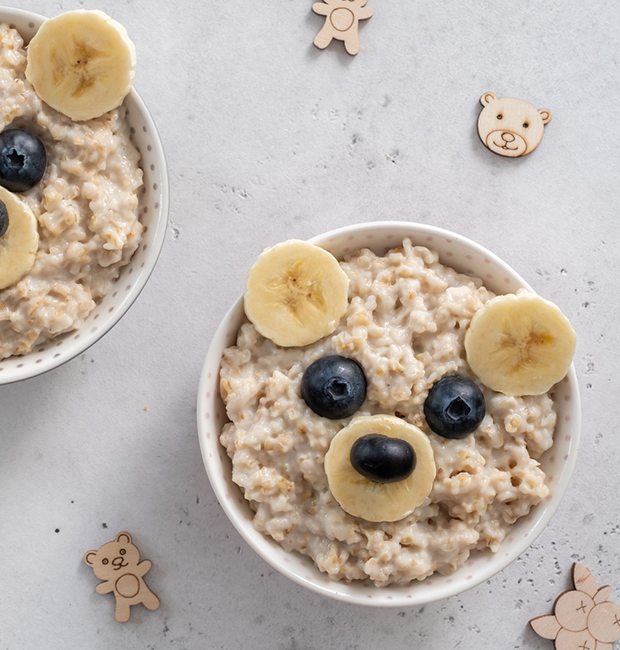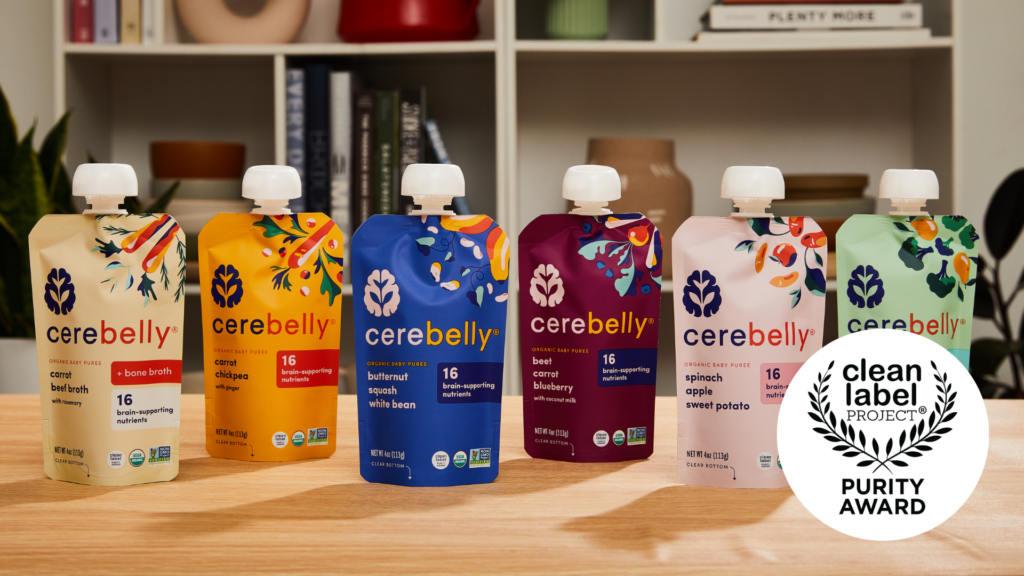Let’s Talk About Sugar in Baby Food
4-min read
Let’s Talk About Sugar in Baby Food
KEY TAKEAWAYS
- Sugar, even natural sugar, should not be the main source of calories in baby food.
- Offer whole fruit as part of a snack or meal, to keep nutrition balanced.
- Flip the package and look at the ingredients. Look for baby foods that are “veggie first” instead of “fruit first.”
Babies love sweet food. In fact, they have an innate preference for it. Offering a sweet fruit puree to our kids is a pretty easy sell. But it’s important to be aware that baby foods that are mostly fruit tend to have a lot of sugar.
Read on to find out why this is a problem and what you can do about it. (Hint: It doesn’t involve avoiding whole fruit!)
Babies need balanced nutrition
When a baby food is mostly fruit, it can contain a lot of sugar. Often baby food is made up of sugary fruit because it’s yummy and makes our little ones reach for more. And we all know how AMAZING it feels when our babies eat it all up! #winning.
The problem arises when fruit-based purees are given too often, and are thought of as a healthy meal, displacing foods that are more nutrient-dense. Babies and toddlers should be getting protein, iron, and B vitamins (just to name a few) in their meals, but these are usually missing in a fruit-based baby food.
It’s not about avoiding fruit altogether. Fruit is a healthy food and an important part of our kids’ diets.
It’s not about avoiding fruit altogether. Fruit is a healthy food and an important part of our kids’ diets. But the nutritional benefits of fruit come from its fiber and vitamin/mineral content, like vitamin C, folate, and potassium. Commercial fruit-based purees usually don’t have much fiber. A better way to get fruit in our kids’ diets is to use mashed-up, fiber-rich whole fruit to enhance the flavor of nutrient-dense foods such as plain unsweetened yogurt. (See the box at the end for some specific ideas.)
Baby food based on fruit can have proportionally too much sugar
When the majority of the calories in a baby food product come from fruit, it means those calories are mostly from sugar. Sugar, even natural sugar, should not be the main source of calories in a baby food. Calories should also come from veggies and protein-rich foods.
An easy way to choose baby food that doesn’t have too much sugar is to look at the ingredient list. Check out the first couple ingredients: They should be veggies or protein-rich foods like chickpeas, peas, or beans.
Natural sugar vs. added sugar
When we talk about sugar in food, it’s important to note that natural sugars are different from added sugars. Natural sugar is lactose from milk and fructose from fruit. Added sugar is everything else. Concentrated fruit juice, fruit syrup, cane syrup, honey, maple syrup, corn syrup solids and dried fruit (if sweetened) are all sources of added sugar.

Is it natural or added sugar?
Natural sugar
Lactose from milk and fructose from fruit.
Added sugar
All other sugars, including concentrated fruit juice, fruit syrup, cane syrup, honey, maple syrup, and corn syrup solids.
These added-sugar ingredients are sometimes found in baby foods, but are mostly a problem in toddler foods. Toddler foods with added sugar are generally marketed to kids 12 months+. But in reality, babies are given these foods earlier than this. A recent study showed that 85% of infants and toddlers consumed added sugar every day. (1) The American Academy of Pediatrics, World Health Organization and Health Canada have recommended little to no added sugar for infants and toddlers under the age of two.
We should all be getting sugar from natural sources rather than added sources, because natural sources give us the nutritional benefits of the whole food.
Our sweeties come by it honestly—they love that sweet taste
It starts in the womb. It carries on with breastfeeding and formula feeding, where we lovingly provide sweet-tasting nourishment to our babies. Their innate love of sweetness can make it challenging to get them to accept less sweet, bitter, or sour foods.
But did you know that babies’ taste preferences can be learned with early and repeated exposures to foods that are not as sweet? Once our little ones start to appreciate foods that are not super sweet, they’re more likely to accept a wide variety of veggies and other nutrient-dense foods that are important for their health. This in turn sets the stage for healthy eating habits later in life, which can reduce the risk of obesity, cardiovascular disease, and even cavities. (1)
3 ways to manage how much sugar your baby gets
Now that you have good info on sugar and your baby, here’s what you can do about it.
- Choose baby food that doesn’t have too much sugar. Here’s how:
- Look at the ingredients list—the first couple ingredients should be veggies or protein-rich foods like chickpeas, peas, or beans.
- Flip the package—in the Nutrition Facts box, look for 0 grams added sugar.
- Give fresh fruit as a snack and use it to enhance the flavor of a more nutrient-dense food at a meal.
- Help your little one learn to like foods that are less sweet (like veggies) by offering them early and often.

Good food ideas
Easy ways to offer whole fruit as a snack or part of a meal
Note: Giving fruit that’s a source of vitamin C along with a plant-based form of iron can increase absorption of the iron.
Mash any soft fruit and add to:
- Unsweetened high-fat plain yogurt
- Iron-fortified oat or barley infant cereal
- Mashed avocado
- Nutrient-dense, ready-to-feed baby food (preferably with protein and iron)
- Homemade oatmeal
- Mashed soft tofu
Finger food:
- Cut soft, ripe mangos, pears, peaches, or bananas into spears. Coat with iron-fortified oat or barley infant cereal
- Grate apples, pears, mangos, or any other firm fruit and serve with soft, shredded chicken
- Bake apple or pear slices and pair with pan-fried tofu
- Bake berries into muffins or pancakes



